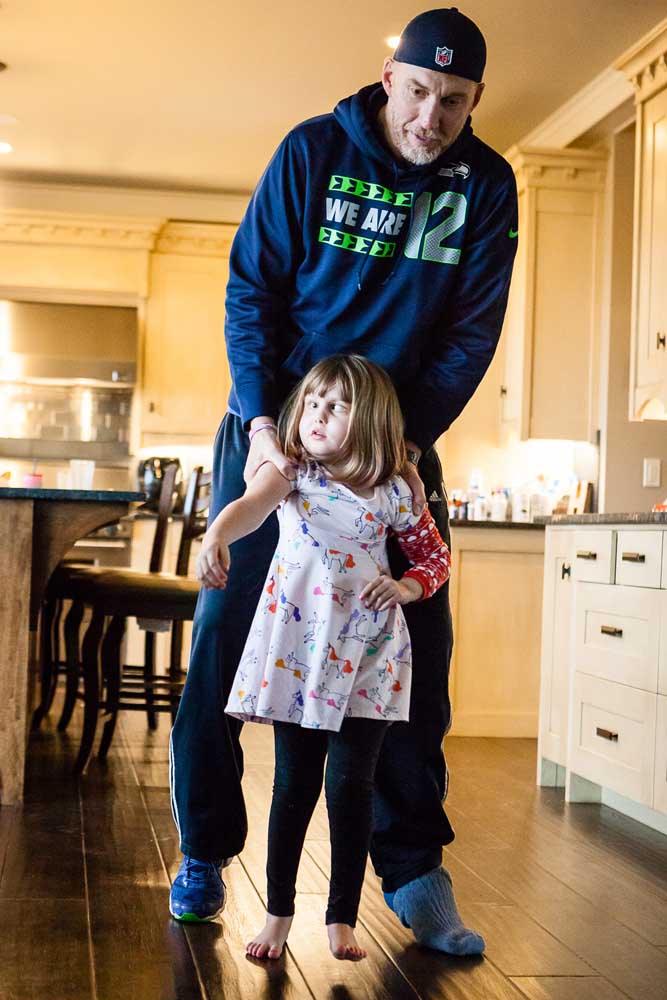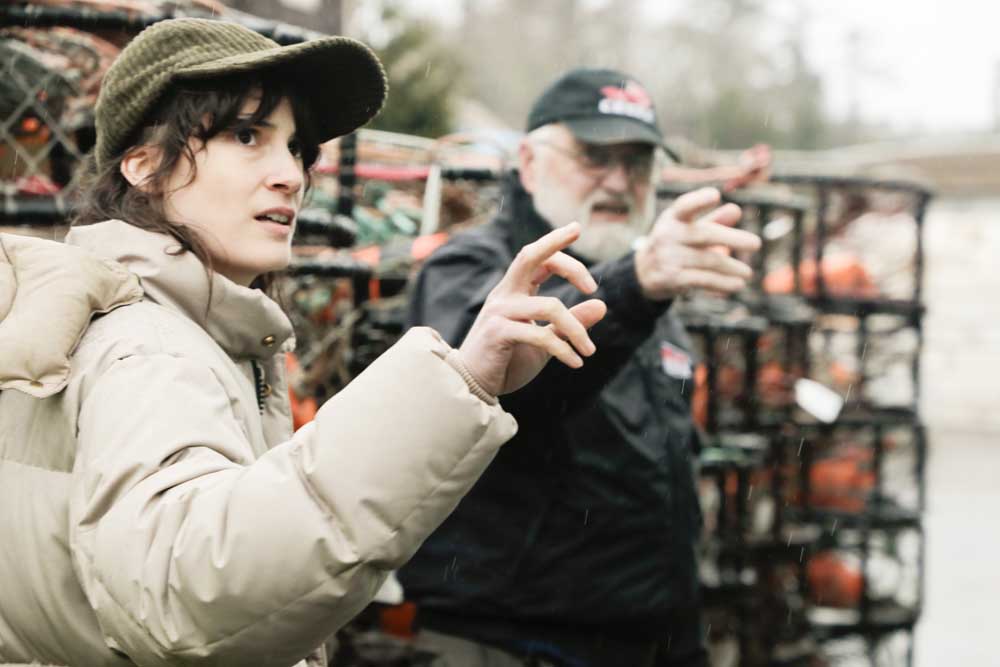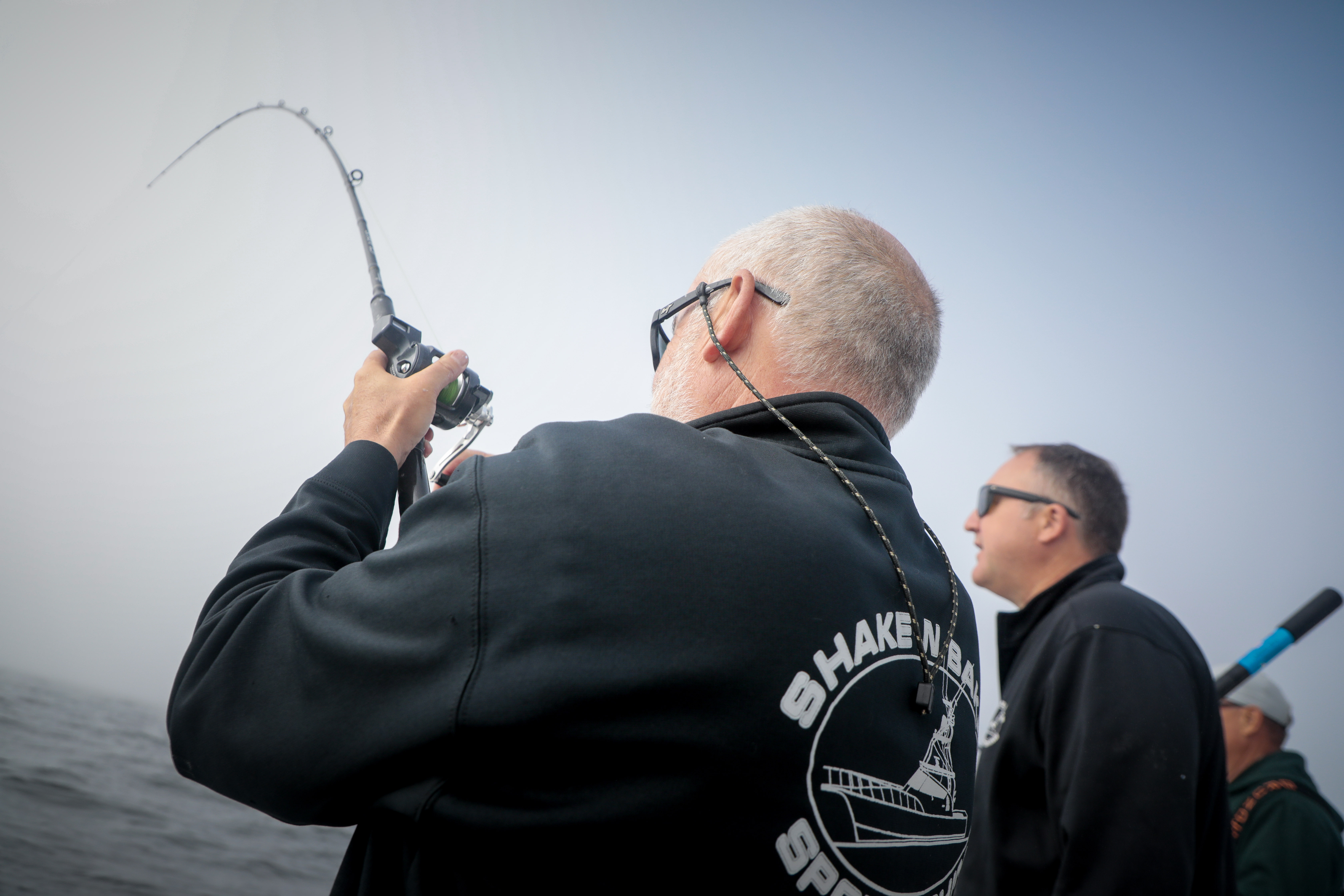Tiny warrior: Peninsula unites for preschooler in the fight of her life
Published 8:51 am Sunday, January 14, 2024

- Jeff Harrell helped his daughter Dylan walk on Nov. 25. She has recently regained some strength, but she is still not able to walk without assistance.
FROM OUR 2018 ARCHIVES
Trending
SEAVIEW — There is a tiny walker in Casey and Jeff Harrell’s living room. It’s an unwanted but constant presence in their lives, which makes it a pretty good metaphor for their daughter’s illness.
In August, four-year-old Dylan Harrell received a crushing diagnosis: Diffuse intrinsic pontine glioma, or DIPG, a type of childhood brain cancer. To date, the disease has had a 100 percent fatality rate. The Harrells are devastated, but not without hope. Bolstered by support from family and community, Jeff, Casey, Dylan and her big brother Mason are fighting the disease every way they know how.
‘Let’s chat’
Over the summer, Dylan’s day care teacher noticed that her left eye was turning in. Their doctor told them to put an eye patch on her stronger eye, but it kept getting worse. Soon, her other eye was turning in too. She started having problems with balance. In July, she started throwing up.
“It became very clear that something’s going on here,” Casey recalled. A family friend helped fast-track an appointment at the Casey Eye Institute in Portland.
“We went in for an eye appointment and had the biggest bomb dropped on us,” Casey said.
“I can remember the doctor going, ‘Let’s chat.’”
‘Go home’
The eye doctor sent them to the emergency room at Doernbecher Children’s Hospital for a basic brain scan. Doctors said they could see something on the pons — a small, but essential part of the brain stem.
“We still had no clue what that meant,” Casey said.
Dylan was admitted to the hospital and scheduled for a full MRI the following day. The Harrells knew they were about to receive terrible news when a doctor called them into a room to talk. The neuro-oncologist cried while telling them Dylan’s diagnosis, but no amount of empathy could soften the blow.
“For lack of better words, I feel like they put you on the death march,” Casey said.
“They told us to just go home and enjoy our time,” Jeff added.
‘Grade three’
The Harrells were dumbstruck at first. How could their sassy, rambunctious, smart, athletic daughter be so sick? At the time, Dylan was learning to ride a bike. She had strong opinions on fashion, and on how her big brother should behave. She thought burps and farts were hilarious. How could a child with so much life-force just fade away?
Further tests and her worsening symptoms quickly forced them to come to terms with DIPG. Dylan may have a less aggressive form of the disease. She has already had more time than many DIPG patients get, but in September, she began having difficulty walking. By October, she couldn’t walk unassisted, and she had developed hydrocephalus — a buildup of fluid in the brain. When doctors treated the hydrocephalus, they also took a biopsy. The results showed that Dylan had a type of tumor known as an anaplastic astrocytoma. It was a “grade three” on a scale of one to four. The battle started in earnest.
‘A horrific few days’
Dylan underwent the first of 30 radiation treatments on Oct. 18. The treatment caused severe inflammation and vomiting and landed Dylan in the intensive care unit. After a second night in the general ward, doctors sent her home with a new prescription for a steroid drug that controls inflammation but causes severe side effects.
“It was a horrific few days,” Casey said. Dylan’s bad reaction had major implications, because radiation is the only treatment proven to alleviate DIPG symptoms. Fortunately, Dylan did much better when they restarted treatment a few days later. In fact, she is the youngest Doernbecher patient to ever undergo radiation without sedation. Her ability to lie still inside the MRI-like machine means treatments take 15 minutes instead of a couple of hours. It also means Dylan doesn’t have to go through the stress and risk of being sedated five times a week.
‘They cannot give us an answer’
For Jeff and Casey, both pharmacists, the limitations of western medicine have become very personal. Jeff reads research papers, consults with other DIPG parents and calls experts all over the world. He recently attended the first-ever summit on DIPG in Washington, D.C. But help is hard to come by. There are treatments being tested in other countries that haven’t made it through the United States’ byzantine approval process. There are promising procedures doctors won’t try and insurance companies won’t approve because they don’t want to be sued if things go awry, and experimental drug trials for which Dylan doesn’t qualify. One of the most promising cancer-fighters — cannabis, is still illegal under federal law.
Jeff respects and appreciates Dylan’s medical team, but finds it maddening to be told again and again that radiation is the only option. To him, it feels like doctors are floating every single DIPG child down the same river, knowing it leads to a giant waterfall.
“If you failed in any other field like that, you would be fired,” Jeff said. “They don’t have that answer for us. That’s the thing we talk about every time we go into the doctor’s offices. They look at us, and they cannot give us an answer.”
‘Really heartfelt’
The Harrells are frank about the fact that, as the part-owners of a successful chain of pharmacies, they have some advantages in the fight against DIPG. Their business partners and employees have taken on most of the day-to-day work, making it possible for them to work part-time, mostly from home. An employee got a friend to loan them a condo near the Portland hospital complex where they currently spend much of their time.
After learning about a promising, but wildly expensive sea cucumber extract, Jeff paid $900 out of pocket for the first month’s supply. Later, he was able to get more of the medicine by enrolling Dylan in a study. They are also able to pay for cancer-fighting cannabis extracts that are not covered by insurance — something Casey says families with less income and community support wouldn’t be able to do.
U.S. Rep. Jaime Herrera Beutler, the mother of a child with a rare, usually fatal disease, invited the Harrells to visit her family in Camas. They took Dylan to their church, where their pastor prayed over her.
“It was really, really heartfelt,” Jeff said. Herrera also used her connections to help the Harrells get access to an experimental drug.
‘I am not into that’
Still, the costs of even standard treatments are astronomical and caring for a sick kid can be overwhelming. On Mondays, family members look after Mason1 while Jeff, Casey and Dylan go to Portland. On top of daily radiation treatments, there are appointments with the neurologist, the oncologist, the naturopath, the cannabis consultant, the physical therapist and the occupational therapist.
Dylan has been a very good sport, her parents say, but certain aspects of her care are major ordeals. Once a week, her providers have to change the sticky dressing that covers the IV port in her left arm.
“I am not into that,” Dylan said. She takes dozens of pills a day. The sea cucumber extract is an unappetizing green-gray slime. It’s tasteless when mixed with juice, but Dylan, a skilled and determined haggler, tries to negotiate her way out of every dose.
Steroids can cause wild mood swings, extreme hunger and crazy sleep schedules. It’s not unusual for Dylan to wake up every two hours, or want a full meal at 3 a.m.
‘Because of what they’ve done for us’
On a Saturday afternoon in mid-November, Mason played calmly while his parents coached Dylan through a steroid-induced tantrum. He “is used to it,” he said. Family members and friends regularly invite Mason to spend time with them. It provides some much-needed normalcy, but his parents still see flashes of anger as he comes to terms with the changes in his life.
“I think it’s hard for an eight-year-old,” Casey said. “He gets the big picture, but then it’s still hard when she’s getting the attention, lots of gifts.” Even adults sometimes feel too overwhelmed by grief and fear to talk with the Harrells. They say they understand.
“This is not something that happens every day, you know?” Jeff said. “You can talk about breast cancer. You can talk about prostate cancer and skin cancer. Those roll off your tongue like household names. But childhood brain cancer? People run.”
Others have gone out of their way to help the family. When the news hit social media, community members began selling bracelets and organizing fundraisers. People bring gifts and meals. They paint rocks and leave them in the driveway for Dylan to find. They write heartfelt emails and provide free childcare. DIPG parents from across the country get in touch.
“There’s times in business when I’ve been abrasive. Those people that I’ve had not-perfect relationships with are people that I will do business with and support the rest of my life because of what they’ve done for us,” Jeff said.
“People who barely know us check in every week to see how we’re doing,” Casey added. “It’s been amazing.”
‘Little things don’t matter’
These days, Casey and Jeff shrug it off when one of the kids chips the paint or breaks a dish. If they see a fight brewing over a bowl of snacks, they pour another bowl.
“The little things don’t matter anymore,” Casey said.
In a house where someone has DIPG, even little victories are big. Two weeks ago, Dylan’s hands shook violently as she tried to eat. She was too tired to talk much, and couldn’t walk at all. On Nov. 25, she was steady enough to eat unaided, take a couple steps with her walker and chat as she dressed her Barbies. The radiation honeymoon is working, for now. Her sense of humor is coming back and she hasn’t vomited in weeks. She’s feeling stronger — she played for about 10 minutes before saying, “Mommy, I’m getting a little bit tired.”
Her good streak brings Casey and Jeff gratitude and joy, but it’s bittersweet. They know it will probably end, and they don’t know when. They find themselves checking constantly for returning symptoms, watching her while she sleeps to make sure she’s still breathing.
“You feel like you have this pressure in your chest, almost like a heart attack,” Jeff said. “It’s like you have trouble breathing. It’s always there.”
‘We aren’t giving up hope’
Regardless of the outcome for Dylan, the Harrells say they’ll be pushing for a cure and advocating for DIPG families for the rest of their lives. They hope, eventually, to start a foundation that would help families cover the costs of things like travel and non-traditional treatments.
They want to repay the kindness people all over the world have shown to them. For now, they’re squarely focused on making Dylan’s life as good as it can be, for as long as possible.
“We aren’t giving up hope,” Casey said. “We don’t want to be the statistic.”









